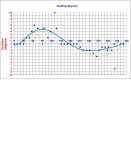Twister_Ken
Well-Known Member
Last weekend there was next to nothing in terms of wind, so we decided to swing the compass. Attached, the resulting table. Errrr - it's not quite the nice serpentine shape, curling either side of the central axis, that the RYA YM books suggest. Quite happy to accept that one or two of my HBC readings might have been a smidge out, but are there dev tables that actually look a bit like this?









